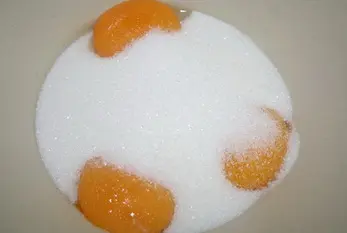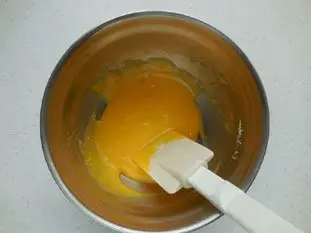Egg yolks and caster sugar

We often come across recipes where we need to mix egg yolks with caster sugar.
This would appear to be a very ordinary and simple thing to do but, be warned, these two ingredients can behave oddly together.
This would appear to be a very ordinary and simple thing to do but, be warned, these two ingredients can behave oddly together.
Last modified on: February 15th 2018
Egg yolks and caster sugar
Let’s take confectioner's custard (crème pâtissière, or french pastry cream) as an example: there’s a stage at which the egg yolks are mixed with the sugar. Is there anything particularly difficult about this? Not really. We mix the yolks and sugar together (without whisking) and that’s all, but there’s an important little tip well worth knowing. You might be tempted to separate the egg yolks from the whites and simply tip them into the weighed-out sugar, as shown in the photo below. Then why not go off to do something else, such as putting the milk on to heat up, before coming back to the egg yolks and sugar mixture later?
Why not? Because you will regret it if you do! Something starts to happen as soon as the egg yolks come into contact with the sugar. The sugar sucks out the water from the egg yolks (we say that sugar is hygroscopic) and this effectively begins to “cook” the surface of the yolks. The result is patches of hard yolk (like in a hard-boiled egg) which will not mix in when you add the boiling milk. These will remain as small lumps in your custard and spoil its normal smooth, creamy texture.
This might not seem like a big deal, but it happens very rapidly. If the egg yolks and sugar are in contact for longer than a minute, the reaction will begin and little hard lumps will start to develop.
How can we avoid this? It’s really quite simple, and this goes for any recipe involving a mixture of egg yolks and sugar: put the egg yolks into bowl, then add the sugar required and mix immediately with a spoon or, better still, with a soft spatula. Once mixed like this, the mixture can be left until later without any problem.
As a precaution, you can do what professional pastry chefs do: 1) make sure you use this method of mixing immediately, 2) strain your mixture of egg yolks+sugar+milk+vanilla+cornflour through a fine sieve when you pour it back into the saucepan. This way, you can be sure that your custard will be perfectly smooth. You might well be surprised by what you see left in the sieve: lumps, milk skin, bits of cooked egg yolk, shreds of vanilla pod…
It is worth mentioning that professional pastry chefs will often strain their cold custard a second time through a very fine sieve before using, to make absolutely sure that the texture is smooth. But maybe that’s going a bit far for us amateurs…
To sum up: A recipe where egg yolks are mixed with sugar? Mix these two together immediately with a soft spatula, then you can safely leave them while you get on with the rest of the recipe.

Why not? Because you will regret it if you do! Something starts to happen as soon as the egg yolks come into contact with the sugar. The sugar sucks out the water from the egg yolks (we say that sugar is hygroscopic) and this effectively begins to “cook” the surface of the yolks. The result is patches of hard yolk (like in a hard-boiled egg) which will not mix in when you add the boiling milk. These will remain as small lumps in your custard and spoil its normal smooth, creamy texture.
This might not seem like a big deal, but it happens very rapidly. If the egg yolks and sugar are in contact for longer than a minute, the reaction will begin and little hard lumps will start to develop.
How can we avoid this? It’s really quite simple, and this goes for any recipe involving a mixture of egg yolks and sugar: put the egg yolks into bowl, then add the sugar required and mix immediately with a spoon or, better still, with a soft spatula. Once mixed like this, the mixture can be left until later without any problem.

As a precaution, you can do what professional pastry chefs do: 1) make sure you use this method of mixing immediately, 2) strain your mixture of egg yolks+sugar+milk+vanilla+cornflour through a fine sieve when you pour it back into the saucepan. This way, you can be sure that your custard will be perfectly smooth. You might well be surprised by what you see left in the sieve: lumps, milk skin, bits of cooked egg yolk, shreds of vanilla pod…

It is worth mentioning that professional pastry chefs will often strain their cold custard a second time through a very fine sieve before using, to make absolutely sure that the texture is smooth. But maybe that’s going a bit far for us amateurs…
To sum up: A recipe where egg yolks are mixed with sugar? Mix these two together immediately with a soft spatula, then you can safely leave them while you get on with the rest of the recipe.
Lasts posts
Butter vs. grease
We often read in a recipe where a pastry is put into a mould that, just before pouring, the mould should be buttered or greased. But what's the difference between these 2 terms?December 1st 20251,0365
Getting out of the fridge early
Very often when you're cooking, you need to take food or preparations out of the fridge, to use them in the recipe in progress. There's nothing tricky about this: you just take them out of the fridge and use them, usually immediately, in the recipe. But is this really a good method?November 24th 20251,1405
Who's making the croissants?
When you look at a bakery from the outside, you naturally think that in the bakery, the bakers make the bread, and in the laboratory, the pastry chefs make the cakes. It's very often like that, with each of these professions having quite different ways of working, but sometimes there's also one...November 23th 20251,031
Oven height
When we put a dish or cake in the oven, we naturally tend to put it on the middle shelf, and that's what we usually do. But in some cases, this position and height can be a little tricky, so let's find out why.October 8th 20252,8085
The importance of sieving
In recipes that use a fine powder (flour, powdered sugar, etc.), you'll often see the advice to sift before using it. To sift is to pass the powder in question through a sieve (a very fine strainer) before incorporating it into your recipe. It's often advice, but is it really useful?September 3rd 20257,5663
Other pages you may also like
Drawing a pattern in pastry
Often in the kitchen, in pastry-making, or in baking, we need to trace a pattern on a pastry. It's just a question of aesthetics but it has its effect after baking on a galette, pithiviers, pâté en croute (terrine in a pie crust), etc.May 23th 201935 K4.1
Candied fruits: don't get ripped off
Do you like candied fruit? You might like to nibble a handful or add it to a recipe, like a classic fruit cake or delicious Italian specialities like panettone or sicilian epiphany pie.June 21th 201767 K 24.2
Perpetual stock
It's something you have probably have done yourself: cooked or pre-cooked vegetables before adding them to a recipe. This is almost always done the same way: peel the chosen vegetables (carrots, for example), cut them up, boil them in salted water (using a tablespoon or so of coarse salt per litre),...November 22th 201631 K5
The golden-brown finish on puff pastry
Let's take a look at the tricky matter of producing puff pastry with an attractive, golden-brown finish. French pastry chefs call this "dorure" (literally, "gilding"). Behind this quirky term there lurks a real problem (and the solution): when using puff pastry (pâte feuilletée) for a pie, or...February 8th 201847 K 24.6
Parsley stems
Parsley, whether curly or flat, is a delicious ingredient in many recipes, where it is used both raw and cooked. When used raw, in a salad for example, where it always provides, alone or with other herbs, a remarkable freshness, only the leaves are kept. And when used cooked?July 28th 20255,705 13
Follow this page
If you are interested in this page, you can "follow" it, by entering your email address here. You will then receive a notification immediately each time the page is modified or a new comment is added. Please note that you will need to confirm this following.
Note: We'll never share your e-mail address with anyone else.
Alternatively: you can subscribe to the mailing list of cooling-ez.com , you will receive a e-mail for each new recipe published on the site.










The 2 comments already posted on this page